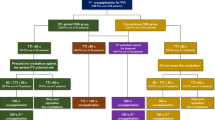Abstract
Background
Cryoballoon technique is an innovative alternative to radiofrequency ablation for atrial fibrillation (AF). However, with current cryoballoon application techniques, the operator has no access to electrical information for 300 s during the freezing cycle.
Objective
The objective of this study is to investigate the novel approach of real-time monitoring of pulmonary vein (PV) potentials throughout freezing using a circular mapping catheter introduced into the central lumen of the cryoballoon catheter.
Methods
Patients had paroxysmal or persistent AF. Standard balloon catheters (23 or 28 mm diameter, 10.5 F shaft) were used. A coaxial mapping catheter (shaft diameter 0.9 mm; 15 mm loop with six electrodes) was advanced through the lumen of the cryoballoon catheter, replacing the guide wire. The primary procedural end point was successful PV isolation and real-time PV potential recording. Secondary end points were procedural data, complications, and the time to successful PV isolation.
Results
In 141 consecutively enrolled patients, balloon positioning and ablation were successful in 439/568 veins (77%). Real-time recording of PV conduction during the freeze cycle was possible in 235/568 PVs (41%). Main reasons for failure to obtain real-time PV recordings were a distal position of the circular mapping catheter or insufficient catheter-vessel wall contact during ablation. A cutoff value of 83 s to PV isolation was predictive of stable procedural PV isolation without reconduction. One minor hemoptysis was observed possibly related to the mapping catheter.
Conclusions
This study, the largest to date, showed that real-time monitoring of PV conduction during cryoballoon freezing can be safely performed with a circular mapping catheter. A cutoff time of 83 s to PV isolation was predictive of sustained procedural PV isolation success without reconduction.





Similar content being viewed by others
Abbreviations
- PV:
-
Pulmonary vein
- PVI:
-
PV isolation
- ROC:
-
Receiver-operated curve
- rPNP:
-
Right phrenic nerve palsy
References
Reddy, V. Y., Neuzil, P., d’Avila, A., et al. (2008). Balloon catheter ablation to treat paroxysmal atrial fibrillation: what is the level of pulmonary venous isolation? Heart Rhythm, 5(3), 353–360.
Sarabanda, A. V., Bunch, T. J., Johnson, S. B., et al. (2005). Efficacy and safety of circumferential pulmonary vein isolation using a novel cryothermal balloon ablation system. Journal of the American College of Cardiology, 46, 1902–1912.
Khairy, P., Chauvet, P., Lehmann, J., et al. (2003). Lower incidence of thrombus formation with cryoenergy versus radiofrequency catheter ablation. Circulation, 107, 2045–2050.
Wong, T., Markides, V., Peters, N. S., & Davies, D. W. (2004). Percutaneous pulmonary vein cryoablation to treat atrial fibrillation. Journal of Interventional Cardiac Electrophysiology, 11, 117–126.
Packer, D. L., Keelan, P., Munger, T. M., et al. (2005). Clinical presentation, investigation, and management of pulmonary vein stenosis complicating ablation for atrial fibrillation. Circulation, 111, 546–554.
Chun, K. R., Fürnkranz, A., Metzner, A., et al. (2009). Cryoballoon pulmonary vein isolation with real-time recordings from the pulmonary veins. Journal of Cardiovascular Electrophysiology, 20, 1203–1210.
Tang, M., Kriatselis, C., Nedios, S., et al. (2010). A novel cryoballoon technique for mapping and isolating pulmonary veins: a feasibility and efficacy study. Journal of Cardiovascular Electrophysiology, 21, 626–631.
Schmidt, B., Chun, K. R. J., Metzner, A., et al. (2009). Pulmonary vein isolation with high-intensity focused ultrasound: results from the HIFU 12F study. Europace, 11, 1281–1288.
Neumann, T., Vogt, J., Schumacher, B., et al. (2008). Circumferential pulmonary vein isolation with the cryoballoon technique results from a prospective 3-center study. Journal of the American College of Cardiology, 52, 273–278.
Twidale, N., Wang, X. Z., Beckman, K. J., et al. (1991). Factors associated with recurrence of accessory pathway conduction after radiofrequency catheter ablation. Pacing and Clinical Electrophysiology, 14, 2042–2048.
Natale, A., Pisano, E., Shewchik, J., et al. (2000). First human experience with pulmonary vein isolation using a through-the-balloon circumferential ultrasound ablation system for recurrent atrial fibrillation. Circulation, 102, 1879–1982.
Sacher, F., Monahan, K. H., Thomas, S. R., et al. (2006). Phrenic nerve injury after atrial fibrillation catheter ablation. Characterization and outcome in a multicenter study. Journal of the American College of Cardiology, 47, 2498–2503.
Schmidt, B., Antz, M., Ernst, S., et al. (2007). Pulmonary vein isolation by high-intensity focused ultrasound: first-in-man study with a steerable balloon catheter. Heart Rhythm, 4, 575–584.
Van Belle, Y., Janse, P., Rivero-Ayerza, M. J., et al. (2007). Pulmonary vein isolation using an occluding cryoballoon for circumferential ablation: feasibility, complications, and short-term outcome. European Heart Journal, 28, 2231–2237.
Koller, M. L., & Schumacher, B. (2009). Cryoballoon ablation of paroxysmal atrial fibrillation: bigger is better and simpler is better. European Heart Journal, 30, 636–637.
Chun, K. R., Schmidt, B., Metzner, A., et al. (2009). The ‘single big cryoballoon’ technique for acute pulmonary vein isolation in patients with paroxysmal atrial fibrillation: a prospective observational single centre study. European Heart Journal, 30, 699–709.
Malmborg, H., Lonnerholm, S., & Blomstrom-Lundqvist, C. (2008). Acute and clinical effects of cryoballoon pulmonary vein isolation in patients with symptomatic paroxysmal and persistent atrial fibrillation. Europace, 10, 1277–1280.
Ahmed, H., Neuzil, P., Skoda, J., et al. (2010). The permanency of pulmonary vein isolation using a balloon cryoablation catheter. Journal of Cardiovascular Electrophysiology, 21, 731–737.
Conflicts of interest
The authors have received speaker honoraria from Medtronic and Biotronik.
Author information
Authors and Affiliations
Corresponding author
Rights and permissions
About this article
Cite this article
Dorwarth, U., Schmidt, M., Wankerl, M. et al. Pulmonary vein electrophysiology during cryoballoon ablation as a predictor for procedural success. J Interv Card Electrophysiol 32, 205–211 (2011). https://doi.org/10.1007/s10840-011-9585-x
Received:
Accepted:
Published:
Issue Date:
DOI: https://doi.org/10.1007/s10840-011-9585-x




